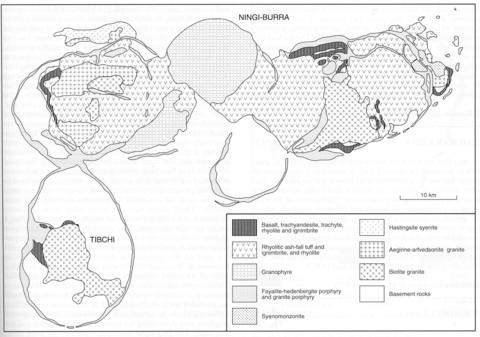stripes
This complex is defined by an elliptical ring-dyke with dimensions of 27x17 km. Almost two thirds of the area enclosed by the ring-dyke is basement granite. The oldest rocks of the complex are volcanics which are preserved in two relatively small areas and which have been divided stratigraphically into 12 units (Ike, 1983; Bennett et al., 1984), the majority being pyroclastic rocks with minor basalt, trachyte and rhyolitic lavas. The pyroclastic rocks are rhyolitic and in one section at least 450 m thick; they include agglomerates, air-fall tuffs and welded lithic, lapilli and crystal tuffs. The welded tuffs are generally recrystallized with relatively coarse alkali feldspar, quartz, fluorite, mica and in one sampled rock arfvedsonite, while other types contain ferrohedenbergite, fayalite, biotite and ferrorichteritic amphibole. An intrusion of quartz porphyry lies between the two areas of volcanics and is truncated by the ring-dyke. The quartz porphyry grades into crystal-rich ignimbrite and represents a feeder for the ring-dyke (Ike et al., 1984). The porphyries contain phenocrysts of quartz, alkali feldspar, fayalite, ferrohedenbergite and, in some varieties, ferroaugite. Biotite granite cuts the porphyries and adjacent to the contact the pyroxenes are altered to amphiboles with the more evolved ferrohedenbergites giving ferrorichterite and arfvedsonite; monazite, titanomagnetite and apatite occur close to the contact. The ring-dyke is of a granite porphyry with phenocrysts of perthite, quartz and ferroaugite/ferrohedenbergite, some with green, more sodic rims. The last intrusive phase is a large biotite granite in which there is extensive development of greisen veins that extend into the basement granites within the ring-dyke and which have a principal mineralogy of quartz, topaz and mica. Accessories include sphalerite, pyrite, arsenopyrite, chalcopyrite, molybdenite and galena, but particular note has been made of the cassiterite and wolframite. The structural evolution of the complex is discussed in some detail by Ike (1983) and analyses of fayalite, pyroxene, amphibole, mica and Fe-Ti oxides are given by Bennett et al. (1984). Rock and mineral analyses of the quartz porphyry and granite porphyries of the ring-dyke are in Ike et al. (1984) who illustrate and discuss at length the genesis of these rocks.
BENNETT, J.N., TURNER, D.C., IKE, E.C. and BOWDEN, P. 1984. The geology of some northern Nigerian anorogenic ring complexes. Overseas Geology and Mineral Resources, 61: 1-65.IKE, E.C. 1983. The structural evolution of the Tibchi ring-complex: a case study for the Nigerian Younger Granite Province. Journal of the Geological Society, London, 140: 781-8.IKE, E.C., BOWDEN, P. and MARTIN, R.F. 1984. Fayalite and clinopyroxene in the porphyries of the Tibchi anorogenic ring-complex, Nigeria: postmagmatic initiation of a peralkaline trend. Canadian Mineralogist, 22: 401-9.KINNAIRD, J.A. 1985. Hydrothermal alteration and mineralization of the alkaline anorogenic ring complexes of Nigeria. Journal of African Earth Sciences, 3: 229-51.RAHAMAN, M.A., VAN BREEMEN, O., BOWDEN, P. and BENNETT, J.N. 1984. Age migrations of anorogenic ring complexes in northern Nigeria. Journal of Geology, 92: 173-84.

